Unit 29: Detailed Report on Promoting Positive Behavior in Healthcare
VerifiedAdded on 2020/06/06
|10
|2177
|46
Report
AI Summary
This report focuses on promoting positive behavior within a healthcare setting, specifically referencing the NHS in the United Kingdom. It begins by examining relevant legislation, such as the Education and Inspection Act 2006 and the Capacity Act 2005, highlighting their importance in establishing a safe and supportive environment. The report then delves into intervention strategies, emphasizing proactive and reactive approaches, functional behavior analyses, and the importance of the least restrictive interventions. Furthermore, it addresses the necessity of safeguarding measures, including legal frameworks and codes of practice. The document also explores the significance of maintaining a person-centered approach, the application of best practices, and the identification of different types of challenging behaviors. Finally, it outlines steps to maintain the dignity of individuals and assess their well-being after incidents of challenging behavior, culminating in a discussion of proactive and reactive strategies to improve the internal and external working environment. The report concludes by emphasizing the importance of legalisation, code of practices, and other factors to ensure safety in the workplace.
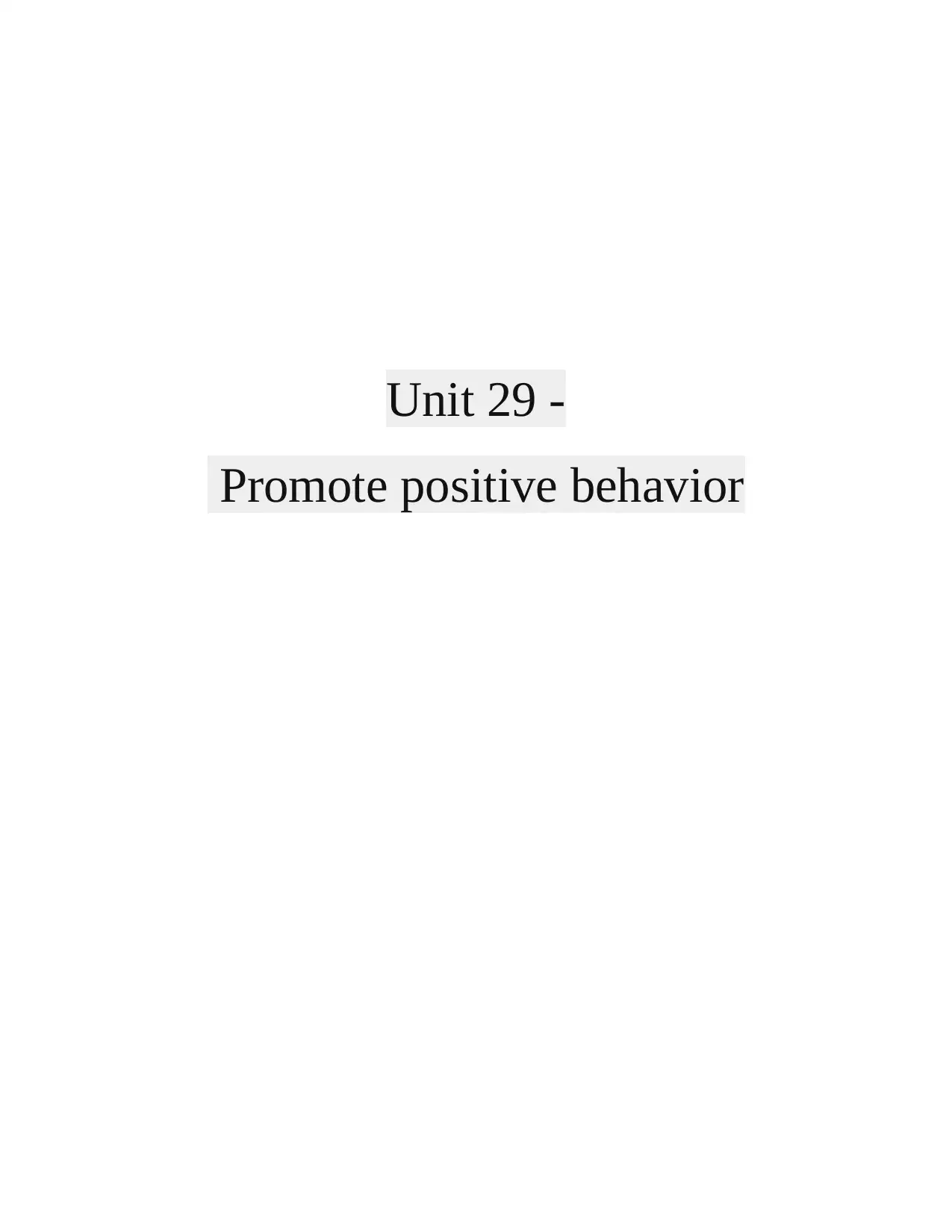
Unit 29 -
Promote positive behavior
Promote positive behavior
Paraphrase This Document
Need a fresh take? Get an instant paraphrase of this document with our AI Paraphraser
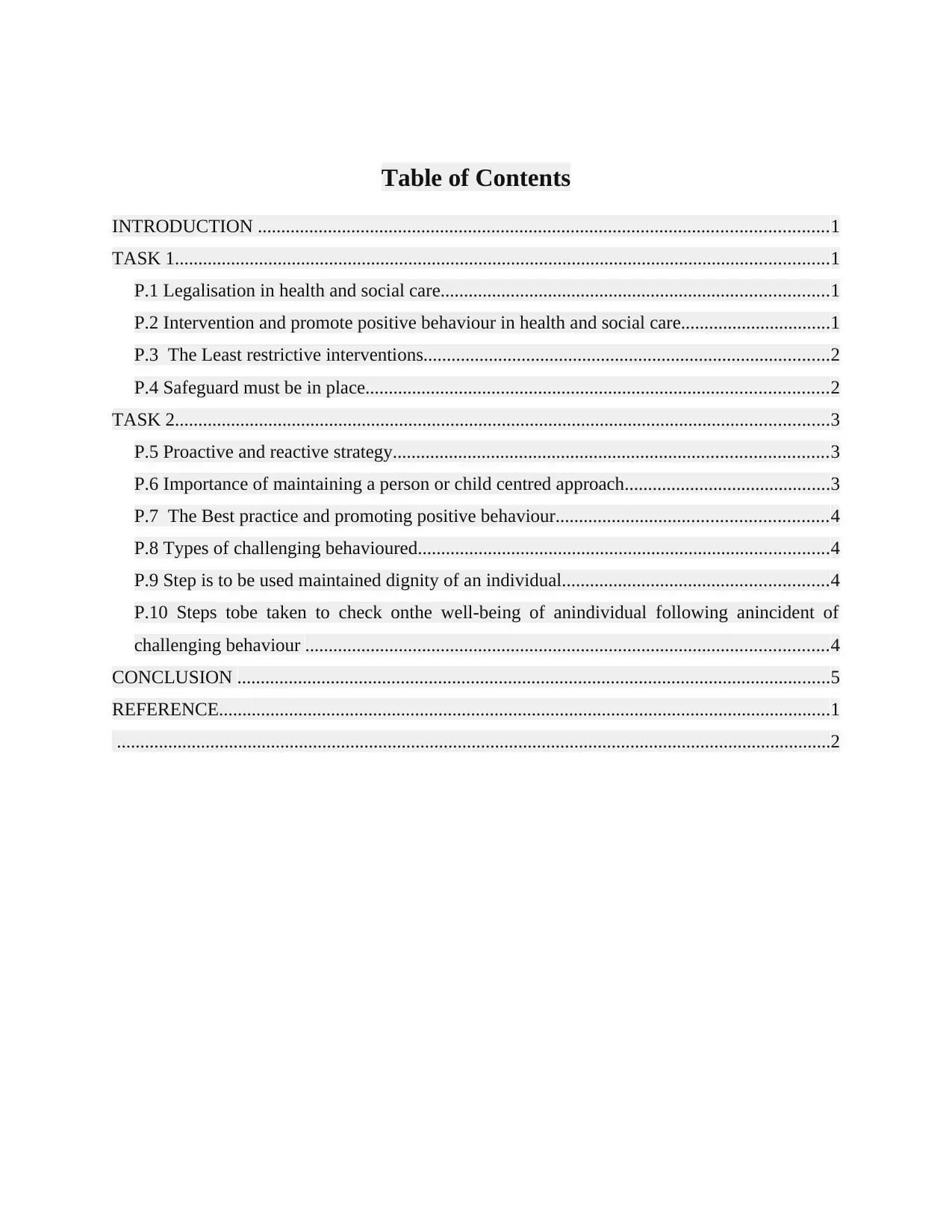
Table of Contents
INTRODUCTION ..........................................................................................................................1
TASK 1............................................................................................................................................1
P.1 Legalisation in health and social care...................................................................................1
P.2 Intervention and promote positive behaviour in health and social care................................1
P.3 The Least restrictive interventions.......................................................................................2
P.4 Safeguard must be in place...................................................................................................2
TASK 2............................................................................................................................................3
P.5 Proactive and reactive strategy.............................................................................................3
P.6 Importance of maintaining a person or child centred approach............................................3
P.7 The Best practice and promoting positive behaviour..........................................................4
P.8 Types of challenging behavioured........................................................................................4
P.9 Step is to be used maintained dignity of an individual.........................................................4
P.10 Steps tobe taken to check onthe well-being of anindividual following anincident of
challenging behaviour ................................................................................................................4
CONCLUSION ...............................................................................................................................5
REFERENCE...................................................................................................................................1
.........................................................................................................................................................2
INTRODUCTION ..........................................................................................................................1
TASK 1............................................................................................................................................1
P.1 Legalisation in health and social care...................................................................................1
P.2 Intervention and promote positive behaviour in health and social care................................1
P.3 The Least restrictive interventions.......................................................................................2
P.4 Safeguard must be in place...................................................................................................2
TASK 2............................................................................................................................................3
P.5 Proactive and reactive strategy.............................................................................................3
P.6 Importance of maintaining a person or child centred approach............................................3
P.7 The Best practice and promoting positive behaviour..........................................................4
P.8 Types of challenging behavioured........................................................................................4
P.9 Step is to be used maintained dignity of an individual.........................................................4
P.10 Steps tobe taken to check onthe well-being of anindividual following anincident of
challenging behaviour ................................................................................................................4
CONCLUSION ...............................................................................................................................5
REFERENCE...................................................................................................................................1
.........................................................................................................................................................2
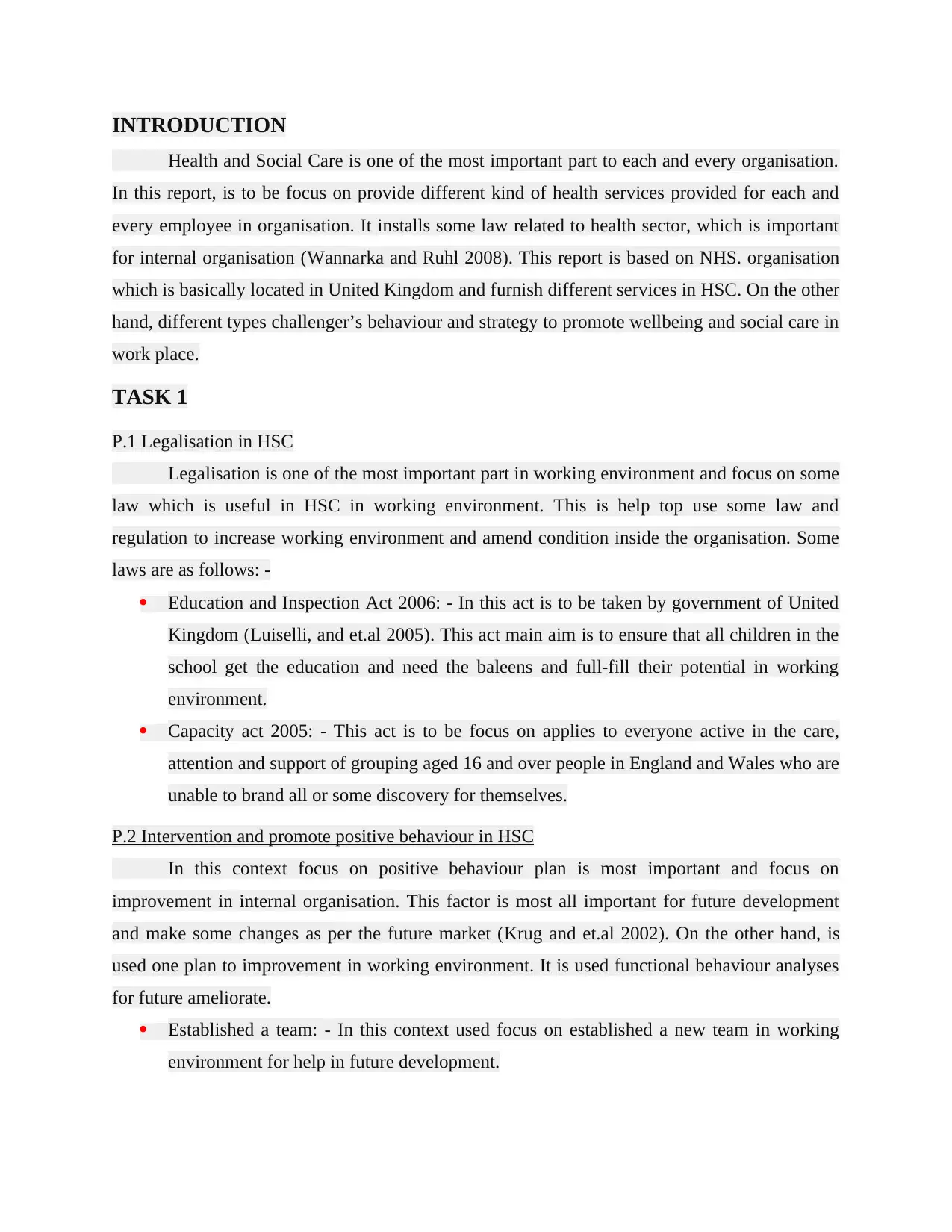
INTRODUCTION
Health and Social Care is one of the most important part to each and every organisation.
In this report, is to be focus on provide different kind of health services provided for each and
every employee in organisation. It installs some law related to health sector, which is important
for internal organisation (Wannarka and Ruhl 2008). This report is based on NHS. organisation
which is basically located in United Kingdom and furnish different services in HSC. On the other
hand, different types challenger’s behaviour and strategy to promote wellbeing and social care in
work place.
TASK 1
P.1 Legalisation in HSC
Legalisation is one of the most important part in working environment and focus on some
law which is useful in HSC in working environment. This is help top use some law and
regulation to increase working environment and amend condition inside the organisation. Some
laws are as follows: -
Education and Inspection Act 2006: - In this act is to be taken by government of United
Kingdom (Luiselli, and et.al 2005). This act main aim is to ensure that all children in the
school get the education and need the baleens and full-fill their potential in working
environment.
Capacity act 2005: - This act is to be focus on applies to everyone active in the care,
attention and support of grouping aged 16 and over people in England and Wales who are
unable to brand all or some discovery for themselves.
P.2 Intervention and promote positive behaviour in HSC
In this context focus on positive behaviour plan is most important and focus on
improvement in internal organisation. This factor is most all important for future development
and make some changes as per the future market (Krug and et.al 2002). On the other hand, is
used one plan to improvement in working environment. It is used functional behaviour analyses
for future ameliorate.
Established a team: - In this context used focus on established a new team in working
environment for help in future development.
Health and Social Care is one of the most important part to each and every organisation.
In this report, is to be focus on provide different kind of health services provided for each and
every employee in organisation. It installs some law related to health sector, which is important
for internal organisation (Wannarka and Ruhl 2008). This report is based on NHS. organisation
which is basically located in United Kingdom and furnish different services in HSC. On the other
hand, different types challenger’s behaviour and strategy to promote wellbeing and social care in
work place.
TASK 1
P.1 Legalisation in HSC
Legalisation is one of the most important part in working environment and focus on some
law which is useful in HSC in working environment. This is help top use some law and
regulation to increase working environment and amend condition inside the organisation. Some
laws are as follows: -
Education and Inspection Act 2006: - In this act is to be taken by government of United
Kingdom (Luiselli, and et.al 2005). This act main aim is to ensure that all children in the
school get the education and need the baleens and full-fill their potential in working
environment.
Capacity act 2005: - This act is to be focus on applies to everyone active in the care,
attention and support of grouping aged 16 and over people in England and Wales who are
unable to brand all or some discovery for themselves.
P.2 Intervention and promote positive behaviour in HSC
In this context focus on positive behaviour plan is most important and focus on
improvement in internal organisation. This factor is most all important for future development
and make some changes as per the future market (Krug and et.al 2002). On the other hand, is
used one plan to improvement in working environment. It is used functional behaviour analyses
for future ameliorate.
Established a team: - In this context used focus on established a new team in working
environment for help in future development.
⊘ This is a preview!⊘
Do you want full access?
Subscribe today to unlock all pages.

Trusted by 1+ million students worldwide
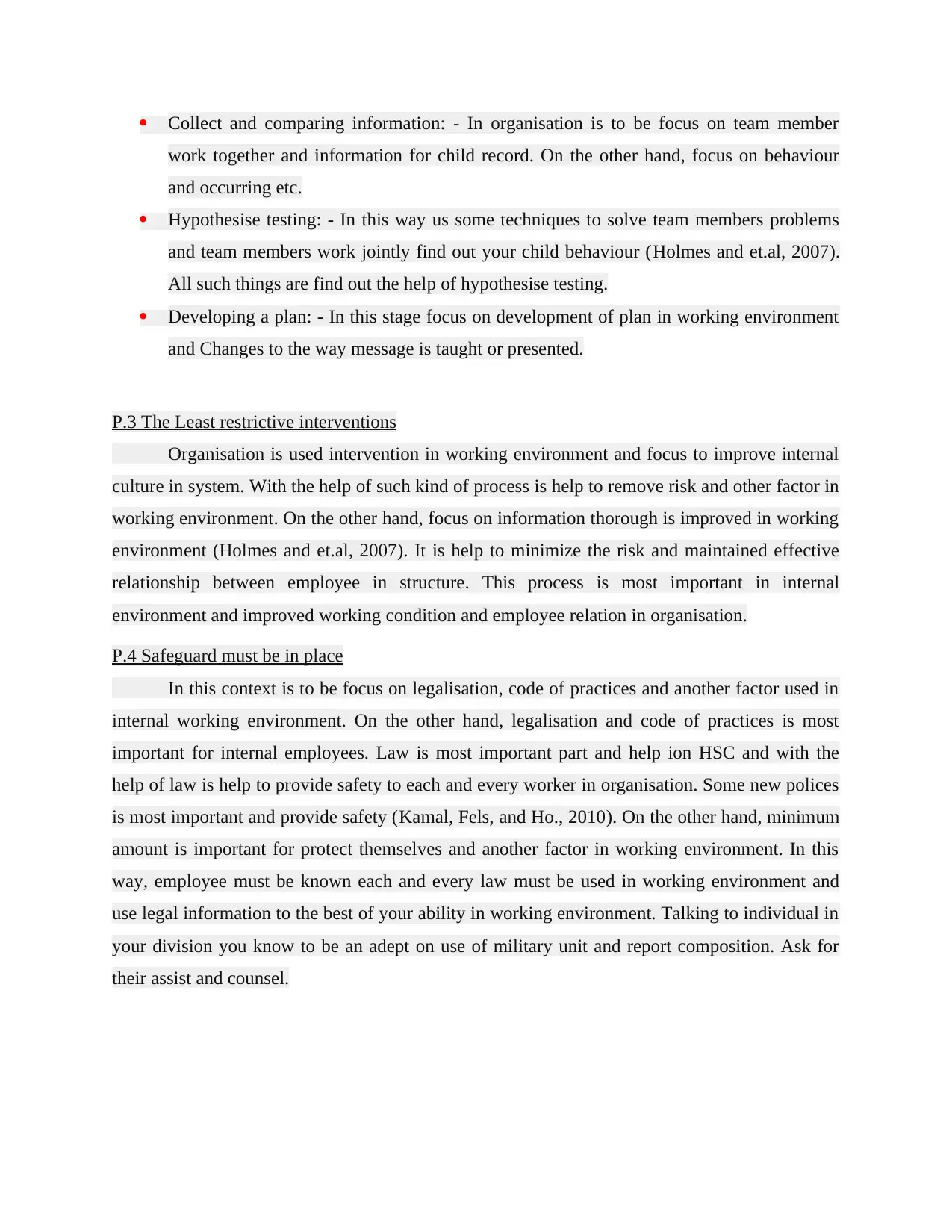
Collect and comparing information: - In organisation is to be focus on team member
work together and information for child record. On the other hand, focus on behaviour
and occurring etc.
Hypothesise testing: - In this way us some techniques to solve team members problems
and team members work jointly find out your child behaviour (Holmes and et.al, 2007).
All such things are find out the help of hypothesise testing.
Developing a plan: - In this stage focus on development of plan in working environment
and Changes to the way message is taught or presented.
P.3 The Least restrictive interventions
Organisation is used intervention in working environment and focus to improve internal
culture in system. With the help of such kind of process is help to remove risk and other factor in
working environment. On the other hand, focus on information thorough is improved in working
environment (Holmes and et.al, 2007). It is help to minimize the risk and maintained effective
relationship between employee in structure. This process is most important in internal
environment and improved working condition and employee relation in organisation.
P.4 Safeguard must be in place
In this context is to be focus on legalisation, code of practices and another factor used in
internal working environment. On the other hand, legalisation and code of practices is most
important for internal employees. Law is most important part and help ion HSC and with the
help of law is help to provide safety to each and every worker in organisation. Some new polices
is most important and provide safety (Kamal, Fels, and Ho., 2010). On the other hand, minimum
amount is important for protect themselves and another factor in working environment. In this
way, employee must be known each and every law must be used in working environment and
use legal information to the best of your ability in working environment. Talking to individual in
your division you know to be an adept on use of military unit and report composition. Ask for
their assist and counsel.
work together and information for child record. On the other hand, focus on behaviour
and occurring etc.
Hypothesise testing: - In this way us some techniques to solve team members problems
and team members work jointly find out your child behaviour (Holmes and et.al, 2007).
All such things are find out the help of hypothesise testing.
Developing a plan: - In this stage focus on development of plan in working environment
and Changes to the way message is taught or presented.
P.3 The Least restrictive interventions
Organisation is used intervention in working environment and focus to improve internal
culture in system. With the help of such kind of process is help to remove risk and other factor in
working environment. On the other hand, focus on information thorough is improved in working
environment (Holmes and et.al, 2007). It is help to minimize the risk and maintained effective
relationship between employee in structure. This process is most important in internal
environment and improved working condition and employee relation in organisation.
P.4 Safeguard must be in place
In this context is to be focus on legalisation, code of practices and another factor used in
internal working environment. On the other hand, legalisation and code of practices is most
important for internal employees. Law is most important part and help ion HSC and with the
help of law is help to provide safety to each and every worker in organisation. Some new polices
is most important and provide safety (Kamal, Fels, and Ho., 2010). On the other hand, minimum
amount is important for protect themselves and another factor in working environment. In this
way, employee must be known each and every law must be used in working environment and
use legal information to the best of your ability in working environment. Talking to individual in
your division you know to be an adept on use of military unit and report composition. Ask for
their assist and counsel.
Paraphrase This Document
Need a fresh take? Get an instant paraphrase of this document with our AI Paraphraser
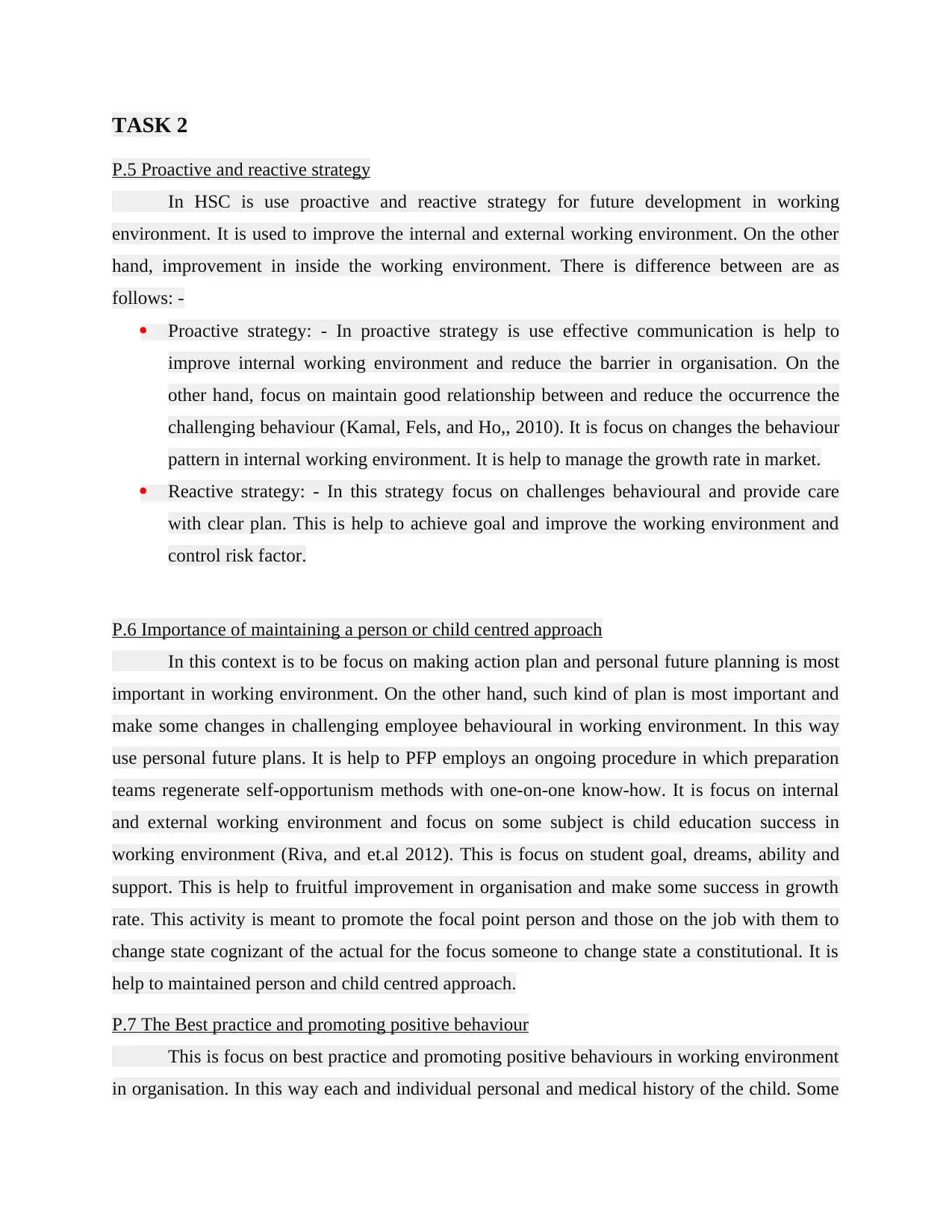
TASK 2
P.5 Proactive and reactive strategy
In HSC is use proactive and reactive strategy for future development in working
environment. It is used to improve the internal and external working environment. On the other
hand, improvement in inside the working environment. There is difference between are as
follows: -
Proactive strategy: - In proactive strategy is use effective communication is help to
improve internal working environment and reduce the barrier in organisation. On the
other hand, focus on maintain good relationship between and reduce the occurrence the
challenging behaviour (Kamal, Fels, and Ho,, 2010). It is focus on changes the behaviour
pattern in internal working environment. It is help to manage the growth rate in market.
Reactive strategy: - In this strategy focus on challenges behavioural and provide care
with clear plan. This is help to achieve goal and improve the working environment and
control risk factor.
P.6 Importance of maintaining a person or child centred approach
In this context is to be focus on making action plan and personal future planning is most
important in working environment. On the other hand, such kind of plan is most important and
make some changes in challenging employee behavioural in working environment. In this way
use personal future plans. It is help to PFP employs an ongoing procedure in which preparation
teams regenerate self-opportunism methods with one-on-one know-how. It is focus on internal
and external working environment and focus on some subject is child education success in
working environment (Riva, and et.al 2012). This is focus on student goal, dreams, ability and
support. This is help to fruitful improvement in organisation and make some success in growth
rate. This activity is meant to promote the focal point person and those on the job with them to
change state cognizant of the actual for the focus someone to change state a constitutional. It is
help to maintained person and child centred approach.
P.7 The Best practice and promoting positive behaviour
This is focus on best practice and promoting positive behaviours in working environment
in organisation. In this way each and individual personal and medical history of the child. Some
P.5 Proactive and reactive strategy
In HSC is use proactive and reactive strategy for future development in working
environment. It is used to improve the internal and external working environment. On the other
hand, improvement in inside the working environment. There is difference between are as
follows: -
Proactive strategy: - In proactive strategy is use effective communication is help to
improve internal working environment and reduce the barrier in organisation. On the
other hand, focus on maintain good relationship between and reduce the occurrence the
challenging behaviour (Kamal, Fels, and Ho,, 2010). It is focus on changes the behaviour
pattern in internal working environment. It is help to manage the growth rate in market.
Reactive strategy: - In this strategy focus on challenges behavioural and provide care
with clear plan. This is help to achieve goal and improve the working environment and
control risk factor.
P.6 Importance of maintaining a person or child centred approach
In this context is to be focus on making action plan and personal future planning is most
important in working environment. On the other hand, such kind of plan is most important and
make some changes in challenging employee behavioural in working environment. In this way
use personal future plans. It is help to PFP employs an ongoing procedure in which preparation
teams regenerate self-opportunism methods with one-on-one know-how. It is focus on internal
and external working environment and focus on some subject is child education success in
working environment (Riva, and et.al 2012). This is focus on student goal, dreams, ability and
support. This is help to fruitful improvement in organisation and make some success in growth
rate. This activity is meant to promote the focal point person and those on the job with them to
change state cognizant of the actual for the focus someone to change state a constitutional. It is
help to maintained person and child centred approach.
P.7 The Best practice and promoting positive behaviour
This is focus on best practice and promoting positive behaviours in working environment
in organisation. In this way each and individual personal and medical history of the child. Some
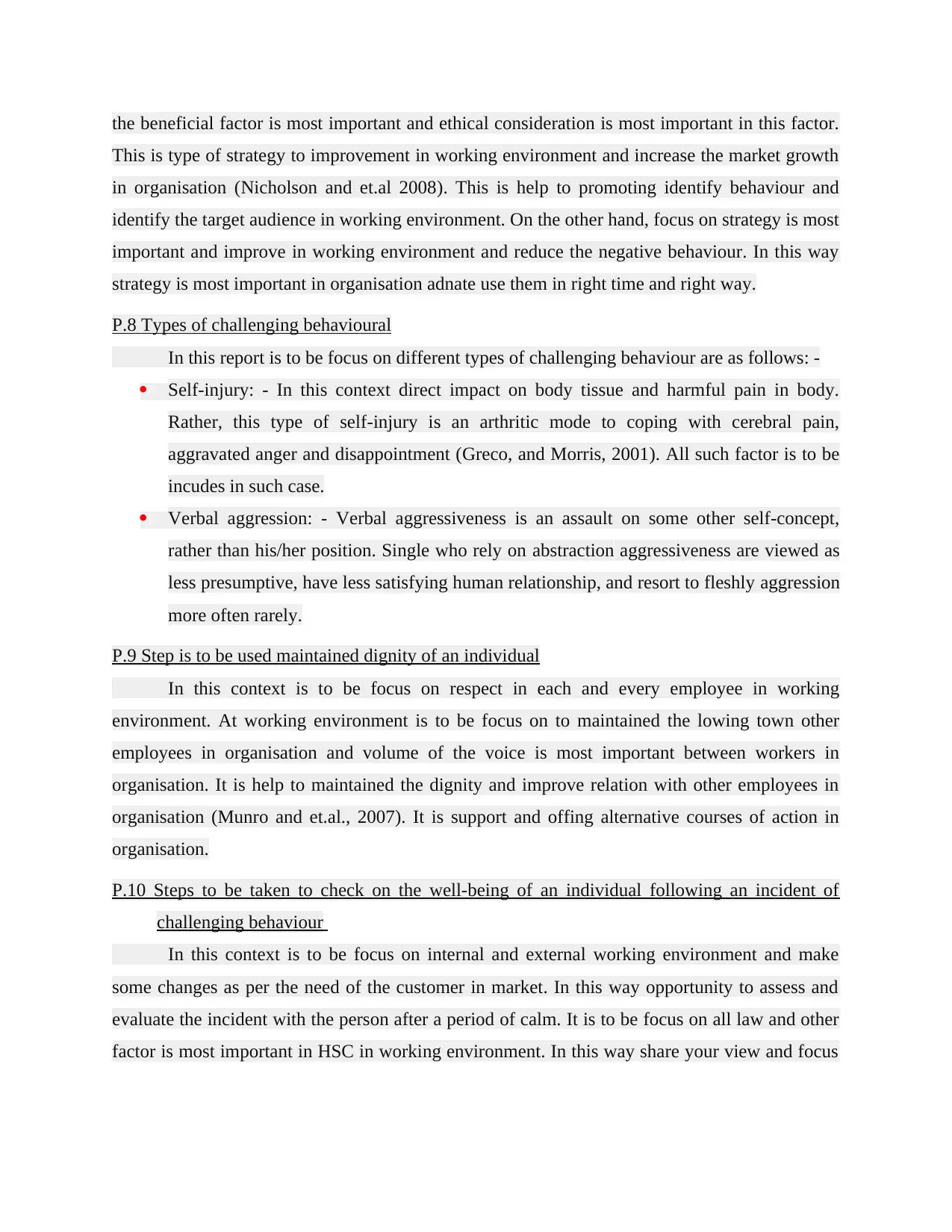
the beneficial factor is most important and ethical consideration is most important in this factor.
This is type of strategy to improvement in working environment and increase the market growth
in organisation (Nicholson and et.al 2008). This is help to promoting identify behaviour and
identify the target audience in working environment. On the other hand, focus on strategy is most
important and improve in working environment and reduce the negative behaviour. In this way
strategy is most important in organisation adnate use them in right time and right way.
P.8 Types of challenging behavioural
In this report is to be focus on different types of challenging behaviour are as follows: -
Self-injury: - In this context direct impact on body tissue and harmful pain in body.
Rather, this type of self-injury is an arthritic mode to coping with cerebral pain,
aggravated anger and disappointment (Greco, and Morris, 2001). All such factor is to be
incudes in such case.
Verbal aggression: - Verbal aggressiveness is an assault on some other self-concept,
rather than his/her position. Single who rely on abstraction aggressiveness are viewed as
less presumptive, have less satisfying human relationship, and resort to fleshly aggression
more often rarely.
P.9 Step is to be used maintained dignity of an individual
In this context is to be focus on respect in each and every employee in working
environment. At working environment is to be focus on to maintained the lowing town other
employees in organisation and volume of the voice is most important between workers in
organisation. It is help to maintained the dignity and improve relation with other employees in
organisation (Munro and et.al., 2007). It is support and offing alternative courses of action in
organisation.
P.10 Steps to be taken to check on the well-being of an individual following an incident of
challenging behaviour
In this context is to be focus on internal and external working environment and make
some changes as per the need of the customer in market. In this way opportunity to assess and
evaluate the incident with the person after a period of calm. It is to be focus on all law and other
factor is most important in HSC in working environment. In this way share your view and focus
This is type of strategy to improvement in working environment and increase the market growth
in organisation (Nicholson and et.al 2008). This is help to promoting identify behaviour and
identify the target audience in working environment. On the other hand, focus on strategy is most
important and improve in working environment and reduce the negative behaviour. In this way
strategy is most important in organisation adnate use them in right time and right way.
P.8 Types of challenging behavioural
In this report is to be focus on different types of challenging behaviour are as follows: -
Self-injury: - In this context direct impact on body tissue and harmful pain in body.
Rather, this type of self-injury is an arthritic mode to coping with cerebral pain,
aggravated anger and disappointment (Greco, and Morris, 2001). All such factor is to be
incudes in such case.
Verbal aggression: - Verbal aggressiveness is an assault on some other self-concept,
rather than his/her position. Single who rely on abstraction aggressiveness are viewed as
less presumptive, have less satisfying human relationship, and resort to fleshly aggression
more often rarely.
P.9 Step is to be used maintained dignity of an individual
In this context is to be focus on respect in each and every employee in working
environment. At working environment is to be focus on to maintained the lowing town other
employees in organisation and volume of the voice is most important between workers in
organisation. It is help to maintained the dignity and improve relation with other employees in
organisation (Munro and et.al., 2007). It is support and offing alternative courses of action in
organisation.
P.10 Steps to be taken to check on the well-being of an individual following an incident of
challenging behaviour
In this context is to be focus on internal and external working environment and make
some changes as per the need of the customer in market. In this way opportunity to assess and
evaluate the incident with the person after a period of calm. It is to be focus on all law and other
factor is most important in HSC in working environment. In this way share your view and focus
⊘ This is a preview!⊘
Do you want full access?
Subscribe today to unlock all pages.

Trusted by 1+ million students worldwide
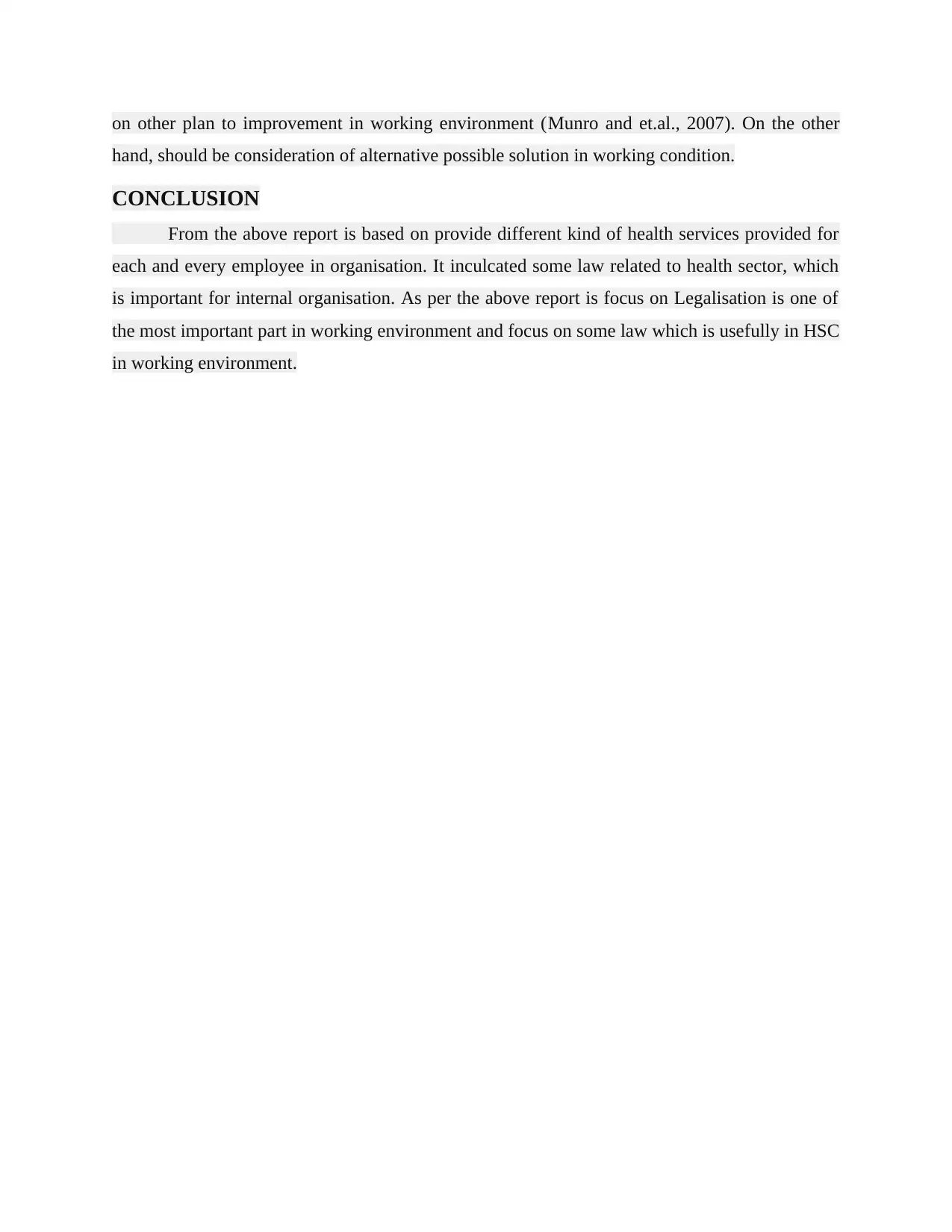
on other plan to improvement in working environment (Munro and et.al., 2007). On the other
hand, should be consideration of alternative possible solution in working condition.
CONCLUSION
From the above report is based on provide different kind of health services provided for
each and every employee in organisation. It inculcated some law related to health sector, which
is important for internal organisation. As per the above report is focus on Legalisation is one of
the most important part in working environment and focus on some law which is usefully in HSC
in working environment.
hand, should be consideration of alternative possible solution in working condition.
CONCLUSION
From the above report is based on provide different kind of health services provided for
each and every employee in organisation. It inculcated some law related to health sector, which
is important for internal organisation. As per the above report is focus on Legalisation is one of
the most important part in working environment and focus on some law which is usefully in HSC
in working environment.
Paraphrase This Document
Need a fresh take? Get an instant paraphrase of this document with our AI Paraphraser
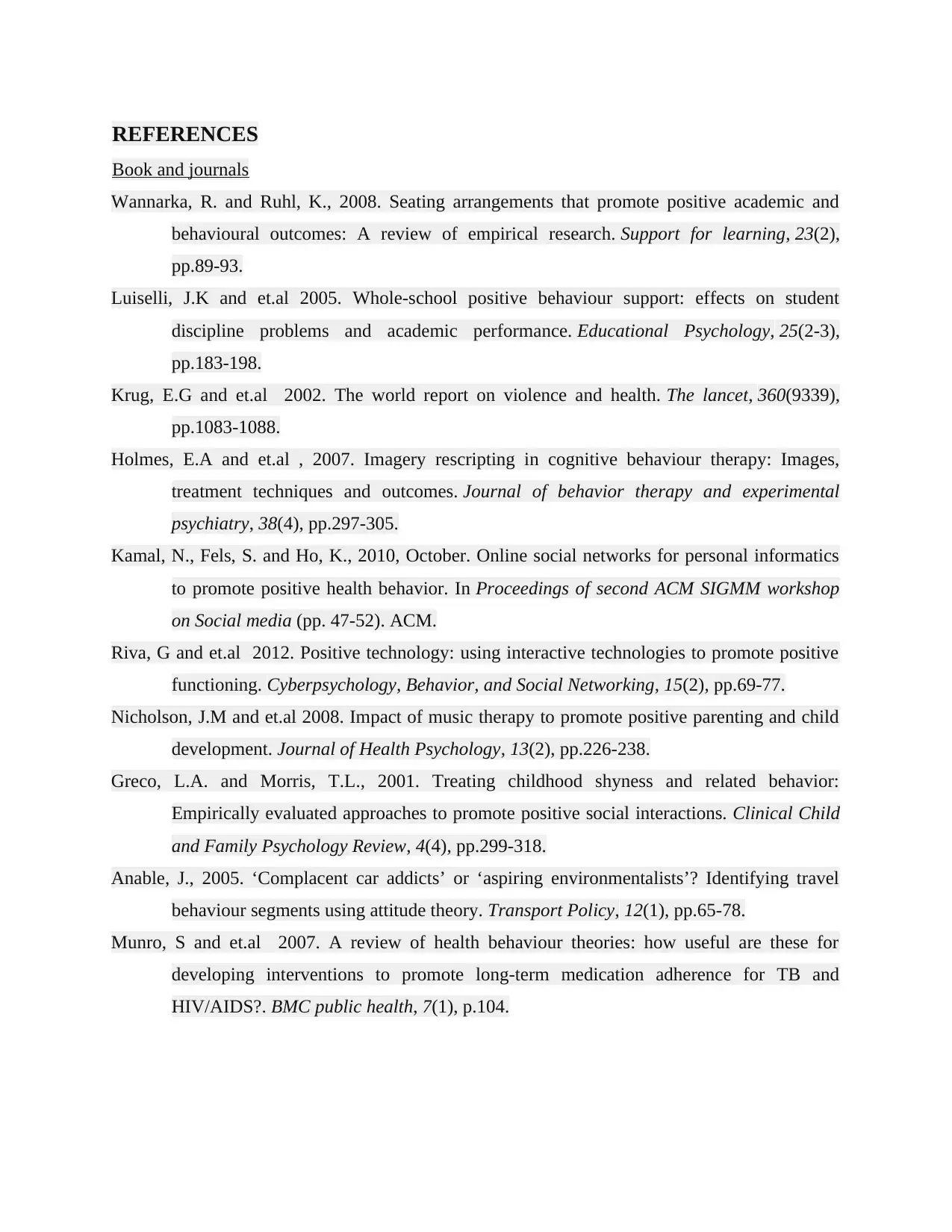
REFERENCES
Book and journals
Wannarka, R. and Ruhl, K., 2008. Seating arrangements that promote positive academic and
behavioural outcomes: A review of empirical research. Support for learning, 23(2),
pp.89-93.
Luiselli, J.K and et.al 2005. Whole‐school positive behaviour support: effects on student
discipline problems and academic performance. Educational Psychology, 25(2-3),
pp.183-198.
Krug, E.G and et.al 2002. The world report on violence and health. The lancet, 360(9339),
pp.1083-1088.
Holmes, E.A and et.al , 2007. Imagery rescripting in cognitive behaviour therapy: Images,
treatment techniques and outcomes. Journal of behavior therapy and experimental
psychiatry, 38(4), pp.297-305.
Kamal, N., Fels, S. and Ho, K., 2010, October. Online social networks for personal informatics
to promote positive health behavior. In Proceedings of second ACM SIGMM workshop
on Social media (pp. 47-52). ACM.
Riva, G and et.al 2012. Positive technology: using interactive technologies to promote positive
functioning. Cyberpsychology, Behavior, and Social Networking, 15(2), pp.69-77.
Nicholson, J.M and et.al 2008. Impact of music therapy to promote positive parenting and child
development. Journal of Health Psychology, 13(2), pp.226-238.
Greco, L.A. and Morris, T.L., 2001. Treating childhood shyness and related behavior:
Empirically evaluated approaches to promote positive social interactions. Clinical Child
and Family Psychology Review, 4(4), pp.299-318.
Anable, J., 2005. ‘Complacent car addicts’ or ‘aspiring environmentalists’? Identifying travel
behaviour segments using attitude theory. Transport Policy, 12(1), pp.65-78.
Munro, S and et.al 2007. A review of health behaviour theories: how useful are these for
developing interventions to promote long-term medication adherence for TB and
HIV/AIDS?. BMC public health, 7(1), p.104.
Book and journals
Wannarka, R. and Ruhl, K., 2008. Seating arrangements that promote positive academic and
behavioural outcomes: A review of empirical research. Support for learning, 23(2),
pp.89-93.
Luiselli, J.K and et.al 2005. Whole‐school positive behaviour support: effects on student
discipline problems and academic performance. Educational Psychology, 25(2-3),
pp.183-198.
Krug, E.G and et.al 2002. The world report on violence and health. The lancet, 360(9339),
pp.1083-1088.
Holmes, E.A and et.al , 2007. Imagery rescripting in cognitive behaviour therapy: Images,
treatment techniques and outcomes. Journal of behavior therapy and experimental
psychiatry, 38(4), pp.297-305.
Kamal, N., Fels, S. and Ho, K., 2010, October. Online social networks for personal informatics
to promote positive health behavior. In Proceedings of second ACM SIGMM workshop
on Social media (pp. 47-52). ACM.
Riva, G and et.al 2012. Positive technology: using interactive technologies to promote positive
functioning. Cyberpsychology, Behavior, and Social Networking, 15(2), pp.69-77.
Nicholson, J.M and et.al 2008. Impact of music therapy to promote positive parenting and child
development. Journal of Health Psychology, 13(2), pp.226-238.
Greco, L.A. and Morris, T.L., 2001. Treating childhood shyness and related behavior:
Empirically evaluated approaches to promote positive social interactions. Clinical Child
and Family Psychology Review, 4(4), pp.299-318.
Anable, J., 2005. ‘Complacent car addicts’ or ‘aspiring environmentalists’? Identifying travel
behaviour segments using attitude theory. Transport Policy, 12(1), pp.65-78.
Munro, S and et.al 2007. A review of health behaviour theories: how useful are these for
developing interventions to promote long-term medication adherence for TB and
HIV/AIDS?. BMC public health, 7(1), p.104.
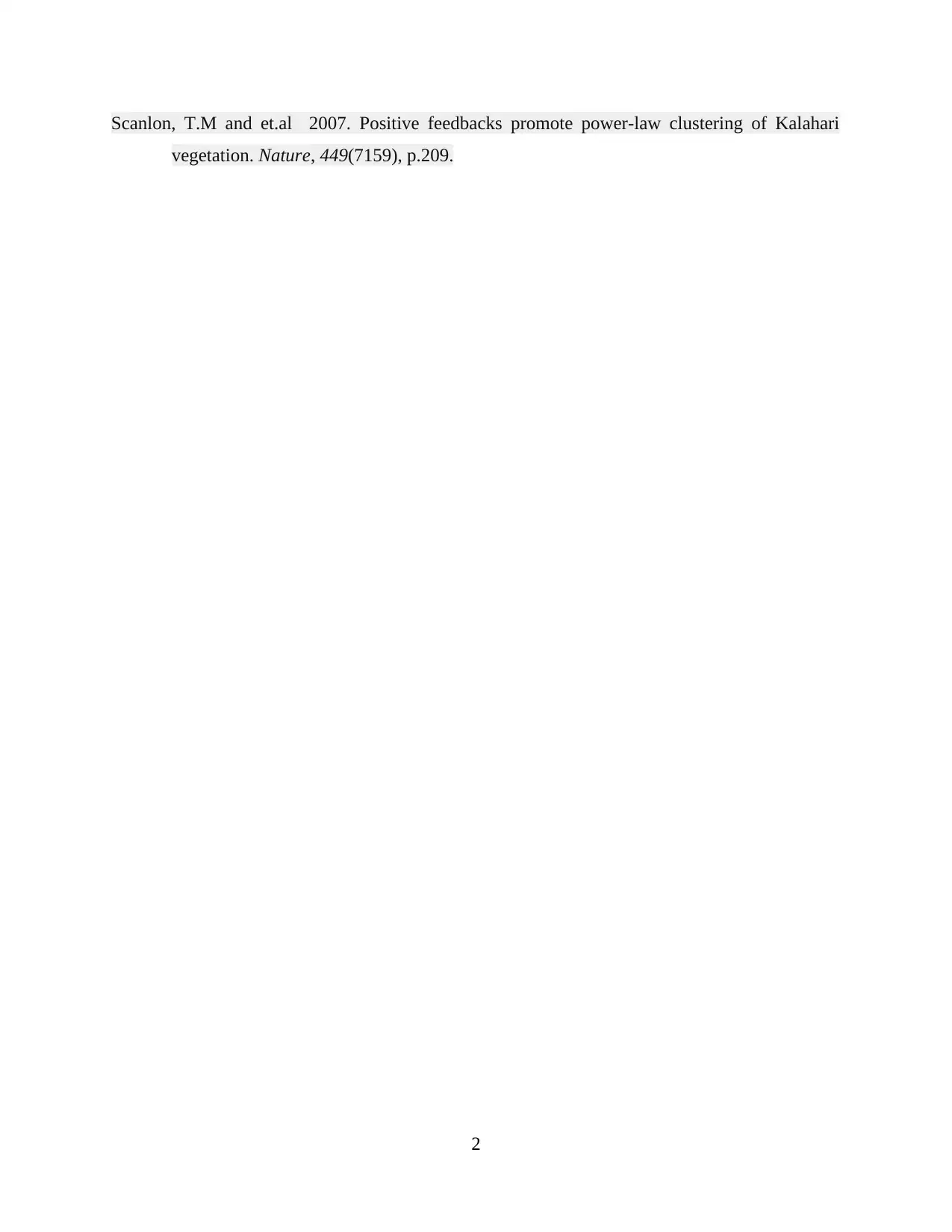
Scanlon, T.M and et.al 2007. Positive feedbacks promote power-law clustering of Kalahari
vegetation. Nature, 449(7159), p.209.
2
vegetation. Nature, 449(7159), p.209.
2
⊘ This is a preview!⊘
Do you want full access?
Subscribe today to unlock all pages.

Trusted by 1+ million students worldwide

3
1 out of 10
Related Documents
Your All-in-One AI-Powered Toolkit for Academic Success.
+13062052269
info@desklib.com
Available 24*7 on WhatsApp / Email
![[object Object]](/_next/static/media/star-bottom.7253800d.svg)
Unlock your academic potential
Copyright © 2020–2025 A2Z Services. All Rights Reserved. Developed and managed by ZUCOL.





